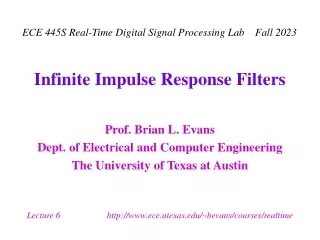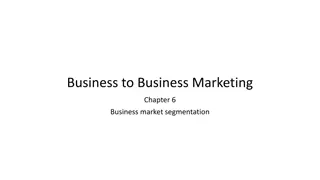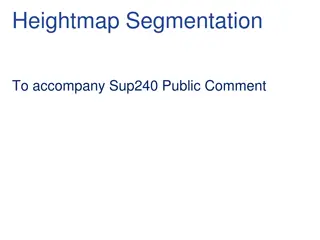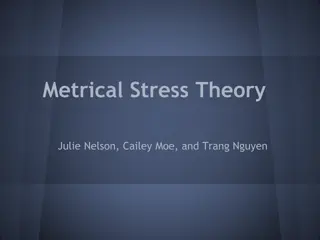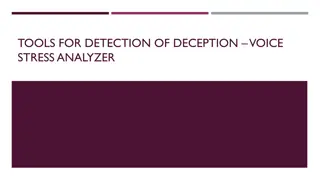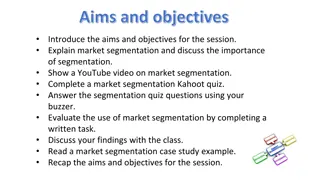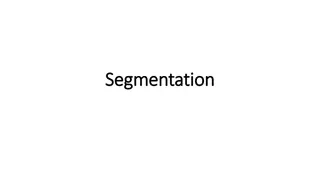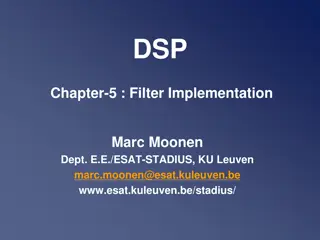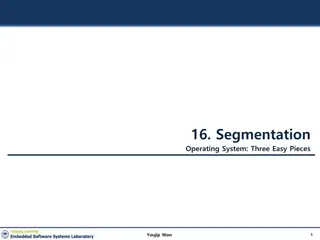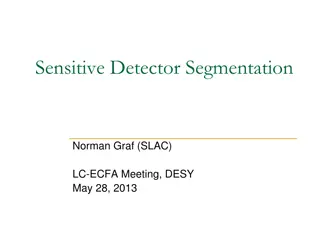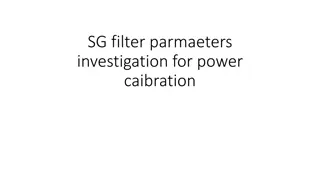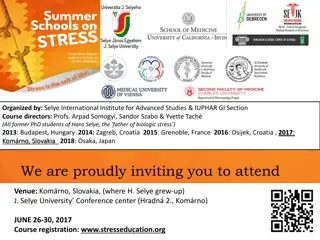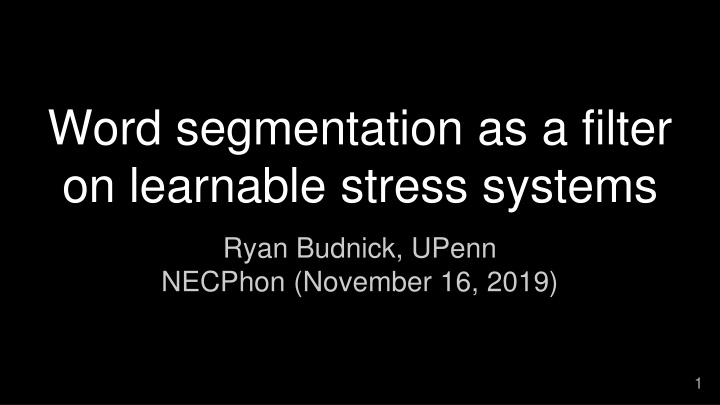
Stress Systems and Word Segmentation: Insights from Learnable Models
Explore the role of stress systems in word segmentation using learnable models. Discover how stress and automata theory, learnability, and early rhythm acquisition influence speech perception in infants. Gain insights into stress patterns and boundaries, with a focus on motivation, mechanism, and case studies.
Download Presentation

Please find below an Image/Link to download the presentation.
The content on the website is provided AS IS for your information and personal use only. It may not be sold, licensed, or shared on other websites without obtaining consent from the author. If you encounter any issues during the download, it is possible that the publisher has removed the file from their server.
You are allowed to download the files provided on this website for personal or commercial use, subject to the condition that they are used lawfully. All files are the property of their respective owners.
The content on the website is provided AS IS for your information and personal use only. It may not be sold, licensed, or shared on other websites without obtaining consent from the author.
E N D
Presentation Transcript
Word segmentation as a filter on learnable stress systems Ryan Budnick, UPenn NECPhon (November 16, 2019) 1
Outline Previous related work Motivation and Mechanism Discrete-Stress Model Framework Case Studies Typology Conclusions and Future Directions 2
Stress and word-boundaries Endlich ist die sogenannte unfreie oder gebundene Betonung auch ein aphonematisches Grenzsignal. [Finally, the so-called non-free or bound stress is also a non-phonemic boundary-signal] Trubetzkoy (1939/1958): 247 Here: Mechanistic explanation through learning; further formalization 4
Stress and automata theory Idsardi (2009): FSA implementations of parametric metrical theory Reveals underlying simplicity Heinz (2009): Automaton-theoretic stress (near?-)universal Includes a natural learning model Here: Perception rather than production, with all that comes with it 5
Stress and learnability Staubs (2014): Stress typological frequencies from learning biases Focuses on MaxEnt HG learners Stanton (2016): Explains away gaps in OT typology with learning Evaluates evidence rareness and ambiguity Here: Representation-agnostic; learner input is utterances, not words 6
Rhythm and stress are learned early Birth 4 months 6 months 9 months Discriminate stress-, syllable-, mora-timed Discriminate trochees from iambs (ERP) Discriminate trochees from iambs (behavioral) (Mehler et al., 1988, Nazzi et al., 1998) (Friederici et al., 2007) (Jusczyk et al., 1993, H hle et al., 2009) 8
Stress is used in early word segmentation English-learning infants around 7-9 months segment trochees and dactyls from English, Dutch, and nonce speech (Jusczyk et al., 1999; Houston et al., 2000; Curtin et al., 2005) Learned behavior: same as Dutch-learning; different from French-learning (Houston et al., 2000; Nazzi et al., 2006) 9
Previous models of stress acquisition Since a data point consists of a single word at a time, the learners here included the assumption that children can successfully identify words in fluent speech by the time they are acquiring the metrical phonology system. Pearl (2011): p. 102 Same in Dresher & Kaye (1990), Tesar (1998), Dresher (1999), Apoussidou (2006), Pearl (2011), Jarosz (2013), etc. Here: Reverse the order (caveat: probably back-and-forth) 10
Feedback Loop Target grammar Un-segmented input Parsing model Segmented input Stress model Properties: Surface-true; contingent on lexicon, syntax, etc. 11
Thesis A stress system is only learnable when there is an efficient parsing algorithm that successfully segments concatenated words 12
A discrete, two-level model of stress Two types of syllables: Unstressed (x); and Stressed (X) One stressed syllable per word A stress system maps from strings of only unstressed syllables to strings with exactly one stressed syllable (e.g. xxxx xxxX ) Utterances look like XxxXxxXxXxxxXXxxX Parsers are Finite-State Transducers (one-syllable-at-a-time, left-to-right)
Implemented Thesis A stress system is only learnable when there is a low-lookahead (cf. Trueswell et al. 1999), low-state FST that provides a parse consistent with it for every utterance concatenated from words generated by it. 15
Case 1: Unbounded lookahead Stress last odd syllable (from left): X, Xx, xxX, xxXx, xxxxX, xxxxXx,... XxnX is always generable! X|X, Xx|X, X|xxX, Xx|xxX, X|xxxxX, Xx|xxxxX,... Even n: segment after first syllable. Odd n: segment after second syllable Must see the next X before segmenting (unboundedly far away) This system is claimed to be unlearnable (Cairene Arabic (McCarthy, 1979) - last nonfinal odd for light sylls.; Creek (Haas, 1977) - last even)
Case 2: Large memory Pre-pre-antepenultimate: X, Xx, Xxx, Xxxx, Xxxxx, xXxxxx, xxXxxxx,... A parser seeing xX must count to five before segmenting Requires five-state FST to be parsed - too high This system is claimed to be unlearnable (Unbounded memory case in bonus slides)
Case 3: Peninitial stress works Peninitial stress is attested: X, xX, xXx, xXxx, xXxxx, xXxxxx,... Boundary between any two stressed syllables, or before any xX X:| x: xXxX x: x: > >| >| >| | >| | : : : X:| X:|
Quantity-insensitive, non-rhythmic typology Number of states Number of states 1 1 2 2 3 3 0 0 Ultimate (1R) 1 1 Initial (1L) Penultimate (2R) Antepenultimate (3R) Lookahead 2 2 Peninitial (2L) Last odd from right Ultimate, flip 2 Initial, flip 2 Penultimate, flip 2 ... 3 3 Postpeninitial (3L) Postpeninitial, flip 2 ...
Syllable Priority Codes (Bailey, 1995; Heinz, 2009; Goedemans et al., 2015) 21 / 2 R Heavy conditions Default Which edge? If penult is heavy, stress it 9 means furthest away , not the ninth syllable Else, if ultima is heavy, stress it Else, stress penult 20
Quantity-sensitive, non-rhythmic typology Number of states 2 3 1 12/1R, 12/2R, 21/1R, 12..89/9R, 12..89/9L, 12..89/1R, 12..89/1L, 23..89/9R 21/2R, 23/3R, 213/2R, 23..89/2R, 23..891/2R, 23..891/9R Lookahead 2 12/1L, 12/2L, 21/1L Svantesson et al. (2005) 12..89/2L 12..89/2L (Goedemans et al., 2015)
Maithili (213/2R) Only attested system of form ABC/DR 123/1R 213/1R 231/1R 321/1R 132/1R 321/1R (3,1) (3,1) (3,1) (3,1) (4,2) (4,2) 123/2R 213/2R 231/2R 321/2R 132/2R 312/2R (3,1) (3,1) (3,1) (4,1) (4,1) (4,2) (5,2) 123/3R 213/3R 231/3R 321/3R 132/3R 312/3R (3,1) (4,1) (5,1) (5,1) (5,2) (6,2) (Memory, Lookahead) 22
What has been explained? Psycholinguistics motivation: Stress acquisition before segmentation Limited cognitive resources Implemented formally with FSAs makes good typological predictions Empirical gap: can learners classify (un)stressed syllables? Theoretical gap: can this be extended to non-primary rhythmic stress? 24
Extending to rhythmic stress Use a continuous model of stress Parser compares stress-levels (Register Automata) Stress systems map strings to partial orders over syllable stress-levels Some early successes, some remaining challenges 25
Extending to interactions Shape of the lexicon (superheavy distribution, minimal word constraints) Morphophonology Syntax and phrasal stress 26
Thank you! Special thanks to Charles Yang and Gene Buckley 27
References Abrahamson, Arne. 1968. Contrastive distribution of phoneme classes in I u Tupi. Anthropological Linguistics 10(6). 11-21. Apoussidou, Diana. 2007. The learnability of metrical phonology (LOT Dissertation Series 148). Utrecht: Netherlands Graduate School of Linguistics. Bailey, Todd. 1995. Nonmetrical constraints on stress. Minneapolis, MN: University of Minnesota dissertation. Curtin, Suzanne, Toben H. Mintz & Morten H. Christiansen. 2005. Stress changes the representational landscape: Evidence from word segmentation. Cognition 96(3). 233-262. Dresher, B. Elan. 1999. Charting the learning path: Cues to parameter setting. Linguistic Inquiry 30(1). 27-67. Dresher, B. Elan & Jonathan D. Kaye. 1990. A computational learning model for metrical phonology. Cognition 34(2). 137-195. Friederici, Angela D., Manuela Friedrich & Anne Christophe. 2007. Brain Responses in 4-Month-Old Infants Are Already Language Specific. Current Biology 17(14). 1208-1211. Goedemans, Rob W. N., Jeffrey Heinz & Harry G van der Hulst. StressTyp2, version 1. 2015. Heinz, Jeffrey. 2009. On the role of locality in learning stress patterns. Phonology 26(2). 303-351. H hle, Barbara, Ranka Bijeljac-Babic, Birgit Herold, J rgen Weissenborn & Thierry Nazzi. 2009. Language specific prosodic preferences during the first half year of life: Evidence from German and French infants. Infant Behavior and Development 32(3). 262-274. Houston, Derek M., Peter W. Jusczyk, Cecile Kuijpers, Riet Coolen & Anne Cutler. 2000. Cross-language word segmentation by 9-month-olds. Psychonomic Bulletin & Review 7(3). 504-509. Hualde, Jos I. 1998. A gap filled: Postpostinitial accent in Azkoitia Basque. Linguistics 36(1). 99-117. Idsardi, William J. 2009. Calculating metrical structure. In Charles Cairns and Eric Raimy (eds.), Contemporary Views on Architecture and Representations in Phonological Theory, 191-211. Cambridge: MIT Press. Jarosz, Gaja. 2013. Learning with hidden structure in Optimality Theory. Phonology 31(1). 27-71. 28
References Jusczyk, Peter W., Anne Cutler & Nancy J Redanz. 1993. Infants' preference for the predominant stress patterns of English words. Child Development 64(3). 675-687. Jusczyk, Peter W., Derek M. Houston & Mary Newsome. 1999. The beginnings of word segmentation in English-learning infants. Cognitive Psychology 39(3). 159-207. Mehler, Jacques, Peter Jusczyk, Ghislaine Lambertzs, Nilofar Halsted, Josiane Bertoncini & Claudine Amiel-Tison. 1988. A precurser of language acquisition in young infants. Cognition 29(2). 143-178. Nazzi, Thiery, Josiane Bertoncini & Jacques Mehler. 1998. Language discrimination by newborns: Toward an understanding of the role of rhythm. Journal of Experimental Psychology: Human Perception and Performance 24(3). 756 766. Nazzi, Thierry, Galina Iakimova, Josiane Bertoncini, S verine Fr donie & Carmela Alcantara. 2006. Early segmentation of fluent speech by infants acquiring French: Emerging evidence for crosslinguistic differences. Journal of Memory and Language 54(3). 283-299. Pearl, Lisa S. 2011. When unbiased probabilistic learning is not enough: Acquiring a parametric system of metrical phonology. Language Acquisition 18(2). 87-120. Stanton, Juliet. 2016. Learnability shapes typology: The case of the midpoint typology. Language 92(4). 753-791. Staubs, Robert D. 2014. Computational Modeling of Learning Biases in Stress Typology. Amherst, MA: UMass Amherst dissertation. Svantesson, Jan-Olof, Anna Tsendina, Vivan Franzen & Anastasia Karlsson. 2005. The phonology of Mongolian. Oxford: Oxford University Press. Tesar, Bruce. 1998. An iterative strategy for language learning. Lingua 104(2). 131-145. Trubetzkoy, Nikolai S. 1958. Grundz ge der Phonologie. G ttigen: Vandenhoeck & Ruprecht. (Original work published 1939) Trueswell, John C., Irina Sekerina, Nicole M. Hill & Marian L. Logrip. 1999. The kindergarten-path effect: studying on-line sentence processing in young children. Cognition 73(2). 89-134. 29
Case N: Unbounded memory If length is 2k+1+1, stress peninitial, else initial: X, Xx, xXx, Xxxx, xXxxx, Xxxxxx,... This was chosen so the number of x s after X in a word is never 2k+1=2,4,8,16,... While parsing, seeing string ...XxnX: if n=2k+1, segment as ...Xxn-1|xX; else, ...Xxn|X (Ambiguous strings like XxXx are parsed Xx|Xx; losing an initial x is never bad) This has only 2 lookahead, but you may need to count unboundedly high to track those powers of 2. So this system is claimed to be unlearnable.
A continuous, infinite-level model of stress Each syllable has a level of stress on a continuum (still unidimensional) The parser only has access to relative measures of stress: Syllable 1 is more stressed than Syllable 2 , not Syllable 1 is stressed . A stress system is a mapping from strings of only unstressed syllables to a partial- ordering over the stress levels (e.g. x1x2x3x4 x1 x3 ) x2 x4 To pronounce, arbitrarily extend the order; utterances look like 1734346545 Parsers look like Register Transducers (one-syllable-at-a-time, left-to-right)
Returning to the thesis A stress system is only learnable when there is a low-lookahead (cf. Trueswell et al. 1999), low-state, low-register RT that provides a parse consistent with it for every utterance concatenated from words generated by it. Problem: all strings are consistent with all systems! Just use all monosyllabic words. Try: ideal parse (longest words)?
Left-right asymmetry Words with right-edge primary stress are much harder to parse than words with left-edge primary stress in this framework, treated conservatively: Consider Ultimate Stress ( x1x2...xn xn>x1,x2,...,xn-1) The only possibly parse of 87654321 is 8|7|6|5|4|3|2|1 The ideal (longest) parse of 876543219 is 876543219 The ideal parse requires unbounded lookahead
Left-right asymmetry Maybe it s not so bad; with lookahead > 1, intermediate left-to-right maxima support longer words (e.g. get 321 43 543 6 as one word with lookahead 3) The learner doesn t need all longest parses, just sufficiently many long parses? Gets worse for antepenultimate stress; for lookahead 3, all antepenultimate systems must have ternary secondary stress. Do we get anything clean explanations from this?
Left-right asymmetry Number of language families in StressTyp2 that have primary stress in the given location and secondary stress on alternating syllables from it: from left from right ` ` ` ` First syllable ` ` ` ` Second syllable (with strict exclusion criteria)
Left-right asymmetry Number of language families in StressTyp2 that have primary stress in the given location and secondary stress on alternating syllables from it: from left from right First syllable 13 4 Second syllable 4 12 (with strict exclusion criteria) Previously explained using representational theory e.g. No Syllabic Iambs (Hayes, 1987)
Left-right asymmetry Ultimate Primary Stress and alternating secondary stresses requires lookahead of at least 4 to overcome secondary stresses that don t increase: 1 2 1 5 1 3 1 6 1 2 1 5|1 3 1 4 For ideal parse, need to see last syllable before segmenting Penultimate Primary Stress and alternating 2arystresses only need lookahead of 3: 1 2 1 5 1 3 1 6 1 1 2 1 5 1|3 1 4 1
Irregular QI Non-rhythmic systems X, Xx, xXx, xxXx, xxXxx, xxXxxx, xxXxxxx,... Azkoitia Basque (Hualde 1998) 4 memory states 3 lookahead 39
Irregular QI Non-rhythmic systems X, Xx, xXx, xxXx, xxXxx, xxxXxx, xxxxXxx,... I u Tupi (Abrahamson 1968) >=4 memory states, >=3 lookahead Haven t found a transducer yet; seems inordinately complicated 40
FSTs (QI) 41

